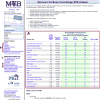The Mouse Tumor Biology Database: A Comprehensive Resource for Mouse Models of Human Cancer
- PMID: 29092943
- PMCID: PMC5679300
- DOI: 10.1158/0008-5472.CAN-17-0584
The Mouse Tumor Biology Database: A Comprehensive Resource for Mouse Models of Human Cancer
Abstract
Research using laboratory mice has led to fundamental insights into the molecular genetic processes that govern cancer initiation, progression, and treatment response. Although thousands of scientific articles have been published about mouse models of human cancer, collating information and data for a specific model is hampered by the fact that many authors do not adhere to existing annotation standards when describing models. The interpretation of experimental results in mouse models can also be confounded when researchers do not factor in the effect of genetic background on tumor biology. The Mouse Tumor Biology (MTB) database is an expertly curated, comprehensive compendium of mouse models of human cancer. Through the enforcement of nomenclature and related annotation standards, MTB supports aggregation of data about a cancer model from diverse sources and assessment of how genetic background of a mouse strain influences the biological properties of a specific tumor type and model utility. Cancer Res; 77(21); e67-70. ©2017 AACR.
©2017 American Association for Cancer Research.
Conflict of interest statement
Conflict of interest disclosure statement: The authors declare no potential conflicts of interest.
Figures

References
-
- Näf D, Krupke DM, Sundberg JP, Eppig JT, Bult CJ. The Mouse Tumor Biology Database: a public resource for cancer genetics and pathology of the mouse. Cancer Res. 2002;62:1235–40. - PubMed
-
- McGonigle P, Ruggeri B. Animal models of human disease: challenges in enabling translation. Biochem Pharmacol. 2014;87:162–71. - PubMed
Publication types
MeSH terms
Grants and funding
LinkOut - more resources
Full Text Sources
Other Literature Sources
Molecular Biology Databases

